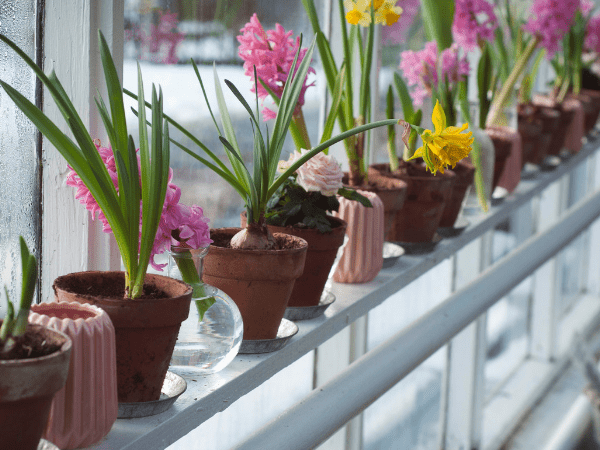Allergy sufferers may become plant haters during the hay fever season. While many flowers, particularly those in the Aster (Asteraceae) family and those pollinated by the wind, can produce a cascade of symptoms, there are still many flowers that should not give you any discomfort.
Some of the most fragrant garden plants are completely free of allergies. The wind doesn’t disperse pollen from flowers like camellias, lilies, and roses. Therefore, they don’t bother people with hay fever.
Furthermore, many new varieties of popular flowers, such as sunflowers, are designed for florists to produce relatively little pollen, which is fantastic for less untidy bouquets but not suitable for allergy sufferers. Of course, there is an increasing number of garden plants planted primarily for their foliage. These plants will not offend anyone if the blossoms are removed.
Azalea (Rhododendron spp.)
Azaleas are a type of woody plant that insects pollinate. Azaleas pollen is rarely released into the wind. Although these spring-blooming shrubs are among the most excellent flowering shrubs for pollen allergies, azalea plants are deadly to humans in all parts, including their pollen. It’s not a good idea to get too close to an azalea blossom.
Begonia (Begonia Groups)
Because begonias are found in almost every shady garden, it’s a good thing they don’t drop a lot of pollen. There are numerous different types of begonias, which are divided into several groupings. Begonias of all varieties, including rex, tuberous, rhizomatous, and semperflorens, are safe choices.
Bougainvillea (Bougainvillea Group)
The bougainvillaea plant’s lovely “flowers” are specialised leaves called bracts that surround the blossoms. Inside the colourful bracts are tiny tubular white blooms that generate very little pollen.
Cactus (Various spp.)
Cactus plants, contrary to popular belief, actually have blooms. Many cacti require cross-pollination with another cactus plant to generate a viable seed, but they do not rely on wind to spread it. Insects and birds look after them in this regard.
Camellia (Camellia spp.)
With their exquisite rose-like blossoms, you may think that Camellias are allergy-inducing plants, but they have “perfect” flowers, which means they have both male and female reproductive organs on the same flower. As a result, their pollen does not have to travel far to pollinate.
Clematis (Clematis spp. and Hybrids)
Except for the North American native Virgin’s Bower (Clematis virginiana) and Sweet Autumn Clematis, most Clematis vines do not upset allergy sufferers (Clematis terniflora). There is low-growing clematis with a shrub-like growth habit in addition to vine-like clematis.
Coleus (Coleus spp.)
Coleus plants’ leaves offer so much colour to the yard that most gardeners clip off the blooms before opening. This will result in a plant that is thicker and lusher. Stem cuttings are a simple way to propagate Coleus plants.
Columbine (Aquilegia spp.)
Although the columbine flower’s brush-like stamens appear to be bursting at the seams with pollen, nectar-loving birds and insects plunge into their turned back spurs in pursuit of sweet nectar, brushing up against their stamens and carrying pollen to the pistil for pollination.
Geranium (Geranium spp.)
Cranesbill geraniums (Geranium spp.) are perennial geraniums that produce very little pollen. Breeders have even developed Pollen-free geraniums. Both annual zonal geraniums (Pelargonium) and annual zonal geraniums (Pelargonium) are pollinated by insects. (While geraniums do not cause sneezing, they do cause contact irritation in some people.)
Hosta (Hosta spp.)
Hosta plants are garden workhorses. Gardeners adore them because they are very low-maintenance. Allergies aren’t a concern because Hosta flowers are frequently chopped off before they blossom. Hosta is cultivated by your nearby nursery to send them by flower delivery in Gujarat for wedding purposes.
Many cultivars, on the other hand, have lovely, delicate blossoms that attract pollinators. Because the wind doesn’t carry the pollen, you can appreciate these delicate blooms without worrying about provoking allergies.
Impatiens (Impatiens spp.)
Impatiens pollen particles are big and sticky, making them ideal for carrying to the next flower by visiting insects but too heavy for the wind to pick up. Due to a large-scale infestation of downy mildew, the common impatiens (Impatiens walleriana) was practically extinct for several years. Still, disease-resistant variants are now available for this long-time favourite.
Orchid (Orchidaceae family)
Although orchid pollen seldom causes allergic reactions, it can cause hay fever in compassionate people, especially if the plant is kept inside. If you are allergic, skin irritations from the sap that some orchids emit are more likely.
Phlox (Phlox. subulata, P. paniculata)
Pollen from phlox plants is not airborne. Therefore the plants are frequently recommended as a substitute for mums. Phlox subulata (creeping phlox) and Phlox paniculata (panicum paniculata) are the most frequent phlox species in gardens (tall garden phlox).
Plants, even succulents, can cause allergies in some people. Anyone who suffers from latex allergies (mainly succulents in the genus Euphorbia). Because of their pollen output, any flowering houseplant has the potential to generate airborne allergies. If you have a pollen allergy, stay away from flowering houseplants such as orchids, Stephanotis, spider plants, and any other flowering houseplant.
Allergies to grasses are the most frequent. Ragweed is one of the most common causes of weed allergies. Sagebrush, pigweed, lamb’s quarters, and tumbleweed are all familiar sources of weed pollen. Pollen from certain tree species, such as birch, cedar, and oak, is highly allergic.

